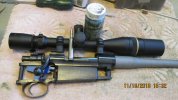Scope mounting & other - the Mauser was designed to be a battle rifle. There are better designs for Long Range Hunting using big fat speedy rounds - like how far do you want to shoot?. The magazine was designed for rounds having a .473 diameter at the base - my preference is to not go for magnum cartridges in a M98 type Mauser. I have done it but regret doing it, altering feed rails can be tricky.
The commercial Mausers not having a thumb slot and stripper clip hump are usually drilled & tapped for scope mounting. I like Warne steel bases and Burris Signature Zee rings, either 1 inch or 30mm. Mounting a 34 mm tube scope on a Mauser would be a new experience for me. The exterior dimensions of these Mausers usually varies a small amount. Screw holes might not be exactly in line.
View attachment 378146
Here is a FN Mauser with Warne Weaver type Bases & Burris Signature Zee Rings. This was a J.C. Higgins M50, an older version with screw 1/2 inch hole spacing on the receiver bridge. The rear Zee Ring was set up with the +20 insert down, the front ring had the + 5 insert on the left side and -5 insert on the right side. This positioned the scope to have a zero close to 200 yards with the reticle close to being centered - very little lateral adjustment needed because the front +5 & -5 inserts. The scope is a Leupold VXIII 4.5-14X40 1 inch tube. The reticle was centered by using a mirror the get a reticle reflection. It has enough elevation to get me on at 600 yards plus and probably more. Warne makes a longer extended front base for real shorty scopes. Burris Medium Sig Zee 1 inch rings were used
It is a 9 twist # 4 Douglas contour McGowen barrel, 24" .280 Rem. I used Brownell's Oxpho cold blue on the bolt handle & extractor. Good stuff, has not worn off yet. I rubbed the Oxpho on with fine steel wool & warmed things up with a hair dryer. Nitrile gloves. Timney M98FN Featherweight trigger.


![IMG_4545[1].JPG](https://r2d2.www.longrangehunting.com/attachments/369/369865-264b115986a2dea8d4f188c0aef4b12c.jpg)
![IMG_4546[1].JPG](https://r2d2.www.longrangehunting.com/attachments/369/369866-d061aef3671a42074b9bb257757d8f52.jpg)
![IMG_4548[1].JPG](https://r2d2.www.longrangehunting.com/attachments/369/369867-14647fbe197a42ba53434106bac2d1ba.jpg)
![IMG_4551[1].JPG](https://r2d2.www.longrangehunting.com/attachments/369/369868-7a75b402759538b484d21307b45969fb.jpg)
![IMG_4554[1].JPG](https://r2d2.www.longrangehunting.com/attachments/369/369869-b23505935cb9a5747a722139334fb852.jpg)
![IMG_4555[1].JPG](https://r2d2.www.longrangehunting.com/attachments/369/369870-2753e87a9d8bfb88a3bfb7b3f3994690.jpg)
![IMG_4556[1].JPG](https://r2d2.www.longrangehunting.com/attachments/369/369871-e2cf4ee60308f9e4a6d19e344dd08b91.jpg)